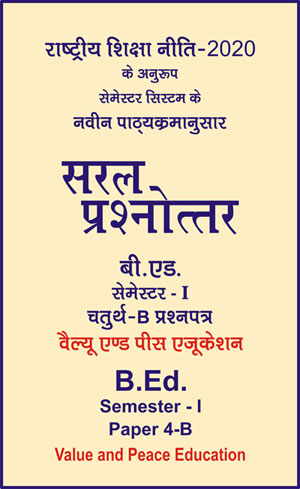|
बी एड - एम एड >> बी.एड. सेमेस्टर-1 प्रश्नपत्र-IV-B - वैल्यू एण्ड पीस एजुकेशन बी.एड. सेमेस्टर-1 प्रश्नपत्र-IV-B - वैल्यू एण्ड पीस एजुकेशनसरल प्रश्नोत्तर समूह
|
5 पाठक हैं |
||||||
बी.एड. सेमेस्टर-1 प्रश्नपत्र-IV-B - वैल्यू एण्ड पीस एजुकेशन (अंग्रेजी भाषा में)
Question- Introduce World War I. Explain its causes and phases also.
Answer -
(1) World War I (WW I), also known as the Great War, lasted from 28 July 1914 to 11 November 1918.
(2) WW I was fought between the Allied Powers and the Central Powers.
(a) The main members of the Allied Powers were France, Russia, and Britain. The United States also fought on the side of the Allies after 1917.
(b) The main members of the Central Powers were Germany, Austria-Hungary, the Ottoman Empire, and Bulgaria.
Causes of The War
There was no single event that led to World War I. The war happened because of several different events that took place in the years building up to 1914.
(1) The new international expansionist policy of Germany : In 1890 the new emperor of Germany, Wilhelm II, began an international policy that sought to turn his country into a world power. Germany was seen as a threat by the other powers and destabilized the international situation.
(2) Mutual Defense Alliances : Countries throughout Europe made mutual defence agreements. These treaties meant that if one country was attacked, allied countries were bound to defend them.
(a) The Triple Alliance-1882 linking Germany with Austria-Hungary and Italy.
(b) The Triple Entente, which was made up of Britain, France, and Russia, concluded by 1907.
(c) Thus, there were two rival groups in Europe.
(3) Imperialism : Before World War I, Africa and parts of Asia were points of contention among the European countries because of their raw materials. The increasing competition and desire for greater empires led to an increase in the confrontation that helped push the world into World War I.
(4) Militarism : As the world entered the 20th century, an arms race had begun. By 1914, Germany had the greatest increase in military buildup. Great Britain and Germany both greatly increased their navies in this time period. This increase in militarism helped push the countries involved into war.
(4) Nationalism : Much of the origin of the war was based on the desire of the Slavic peoples in Bosnia and Herzegovina to no longer be part of Austria Hungary but instead be part of Serbia. In this way, nationalism led to the War.
(5) Assassination of Archduke Franz Ferdinand : In June 1914, Archduke Franz Ferdinand, the heir to the throne of Austria-Hungary, was shot while he was visiting Sarajevo in Bosnia. He was killed by a Serbian person, who thought that Serbia should control Bosnia instead of Austria. Because its leader had been shot, Austria-Hungary declared war on Serbia. As a result:
(a) Russia got involved as it had an alliance with Serbia.
(b) Germany then declared war on Russia because Germany had an alliance with Austria-Hungary.
(c) Britain declared war on Germany because of its invasion of neutral Belgium - Britain had agreements to protect both Belgium and France.
(6) Some of the major battles during the war included the First Battle of the Marne, Battle of the Somme, Battle of Tannenberg, Battle of Gallipoli, and the Battle of Verdun.
Phases of The War(1) The conflict developed on several fronts in Europe, Africa, and Asia. The two main scenarios were the Western front, where the Germans confronted Britain, France and, after 1917, the AmericAnswer The second front was the Eastern front in which the Russians fought against Germans and Austro-HungariAnswer
(2) After a brief German advance in 1914, the western front was stabilized and a long and brutal trench warfare started: it was a "war of attrition" (the western front remained immovable). Meanwhile on the Eastern Front the Germans advanced but not decisively.
(3) In 1917, two events changed the course of the war: the United States joined the Allies and Russia, after the Russian revolution, abandoned the conflict and signed a separate peace.
(4) Finally after the German offensive in the spring of 1918, the Allied counterattack managed to force a decisive retreat of the German army. The defeat of Germany’s allies and the revolution in Germany that dethroned Wilhelm II (German Emperor), brought about the signing of the armistice on November 11, 1918. The Great War was over.
|
|||||













